Researching the Impact of Waste Paint and GGBS in Concrete
VerifiedAdded on 2022/08/20
|19
|3615
|17
Report
AI Summary
This research proposal explores the effects of using waste paint and Ground Granulated Blast Furnace Slag (GGBS) as additives in concrete. The study aims to assess the impact of these waste materials on concrete's workability and compressive strength. Waste paint, similar to polymeric admixtures, can enhance workability and bonding, while GGBS, a byproduct of iron-making, can replace cement, reducing carbon dioxide emissions. The proposal reviews existing literature on the use of waste paint and GGBS in concrete, highlighting their potential to improve concrete properties and promote sustainability. The methodology outlines experiments to investigate the workability and compressive strength of concrete mixes with varying proportions of waste paint and GGBS, providing a basis for future research and practical applications.

Research proposal
2020
2020
Paraphrase This Document
Need a fresh take? Get an instant paraphrase of this document with our AI Paraphraser
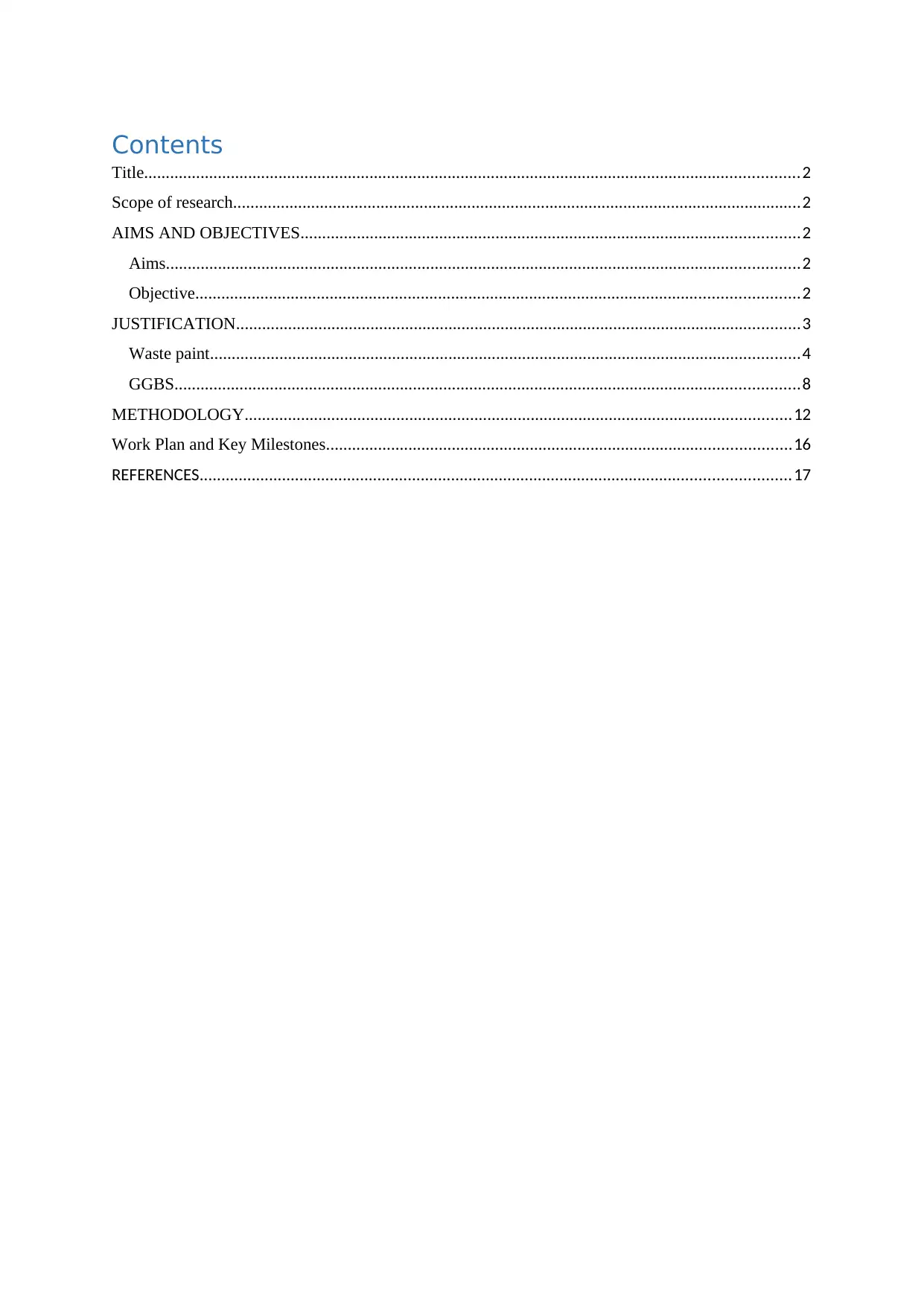
Contents
Title.......................................................................................................................................................2
Scope of research...................................................................................................................................2
AIMS AND OBJECTIVES...................................................................................................................2
Aims..................................................................................................................................................2
Objective...........................................................................................................................................2
JUSTIFICATION..................................................................................................................................3
Waste paint........................................................................................................................................4
GGBS................................................................................................................................................8
METHODOLOGY..............................................................................................................................12
Work Plan and Key Milestones...........................................................................................................16
REFERENCES........................................................................................................................................17
Title.......................................................................................................................................................2
Scope of research...................................................................................................................................2
AIMS AND OBJECTIVES...................................................................................................................2
Aims..................................................................................................................................................2
Objective...........................................................................................................................................2
JUSTIFICATION..................................................................................................................................3
Waste paint........................................................................................................................................4
GGBS................................................................................................................................................8
METHODOLOGY..............................................................................................................................12
Work Plan and Key Milestones...........................................................................................................16
REFERENCES........................................................................................................................................17
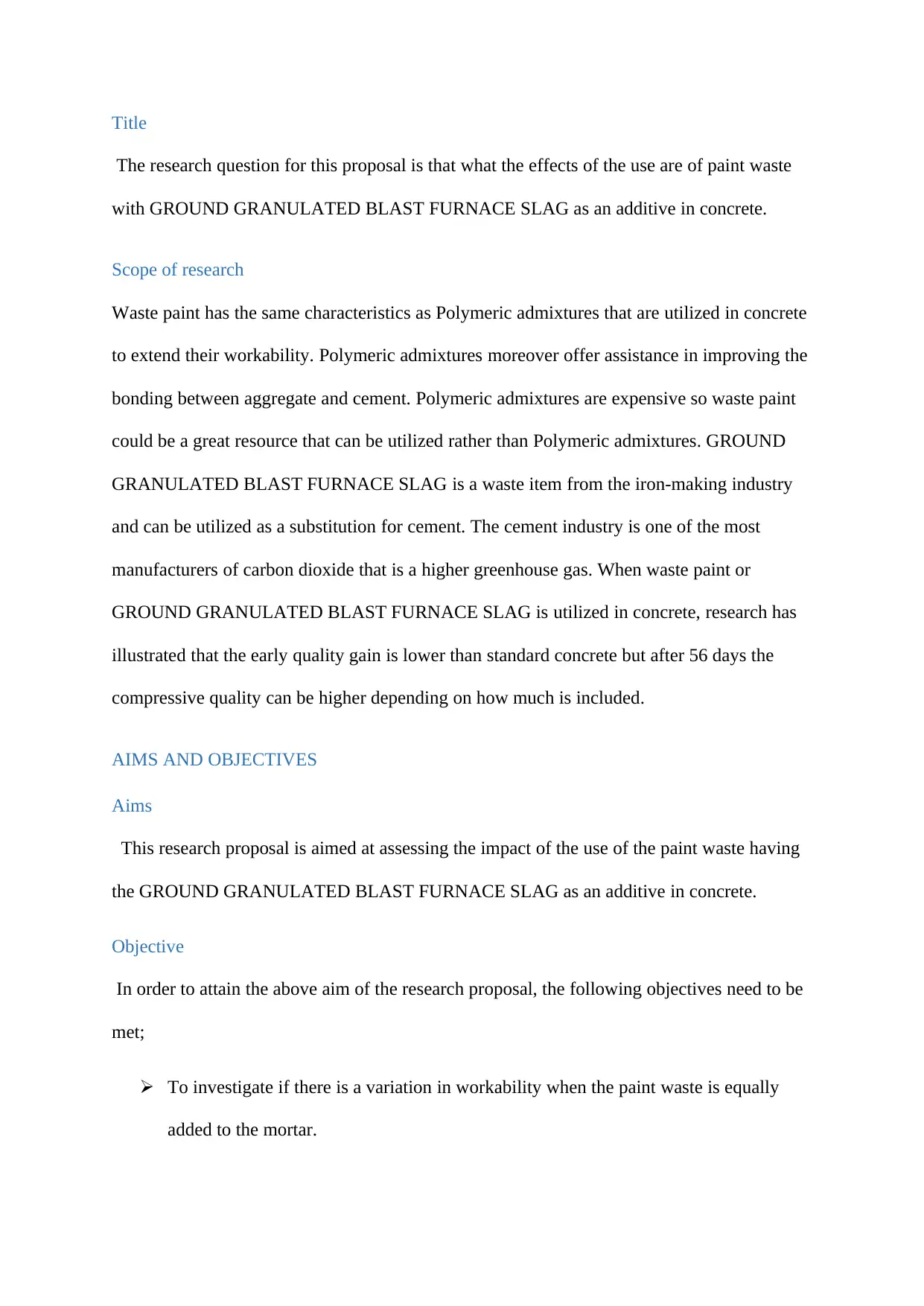
Title
The research question for this proposal is that what the effects of the use are of paint waste
with GROUND GRANULATED BLAST FURNACE SLAG as an additive in concrete.
Scope of research
Waste paint has the same characteristics as Polymeric admixtures that are utilized in concrete
to extend their workability. Polymeric admixtures moreover offer assistance in improving the
bonding between aggregate and cement. Polymeric admixtures are expensive so waste paint
could be a great resource that can be utilized rather than Polymeric admixtures. GROUND
GRANULATED BLAST FURNACE SLAG is a waste item from the iron-making industry
and can be utilized as a substitution for cement. The cement industry is one of the most
manufacturers of carbon dioxide that is a higher greenhouse gas. When waste paint or
GROUND GRANULATED BLAST FURNACE SLAG is utilized in concrete, research has
illustrated that the early quality gain is lower than standard concrete but after 56 days the
compressive quality can be higher depending on how much is included.
AIMS AND OBJECTIVES
Aims
This research proposal is aimed at assessing the impact of the use of the paint waste having
the GROUND GRANULATED BLAST FURNACE SLAG as an additive in concrete.
Objective
In order to attain the above aim of the research proposal, the following objectives need to be
met;
To investigate if there is a variation in workability when the paint waste is equally
added to the mortar.
The research question for this proposal is that what the effects of the use are of paint waste
with GROUND GRANULATED BLAST FURNACE SLAG as an additive in concrete.
Scope of research
Waste paint has the same characteristics as Polymeric admixtures that are utilized in concrete
to extend their workability. Polymeric admixtures moreover offer assistance in improving the
bonding between aggregate and cement. Polymeric admixtures are expensive so waste paint
could be a great resource that can be utilized rather than Polymeric admixtures. GROUND
GRANULATED BLAST FURNACE SLAG is a waste item from the iron-making industry
and can be utilized as a substitution for cement. The cement industry is one of the most
manufacturers of carbon dioxide that is a higher greenhouse gas. When waste paint or
GROUND GRANULATED BLAST FURNACE SLAG is utilized in concrete, research has
illustrated that the early quality gain is lower than standard concrete but after 56 days the
compressive quality can be higher depending on how much is included.
AIMS AND OBJECTIVES
Aims
This research proposal is aimed at assessing the impact of the use of the paint waste having
the GROUND GRANULATED BLAST FURNACE SLAG as an additive in concrete.
Objective
In order to attain the above aim of the research proposal, the following objectives need to be
met;
To investigate if there is a variation in workability when the paint waste is equally
added to the mortar.
⊘ This is a preview!⊘
Do you want full access?
Subscribe today to unlock all pages.

Trusted by 1+ million students worldwide
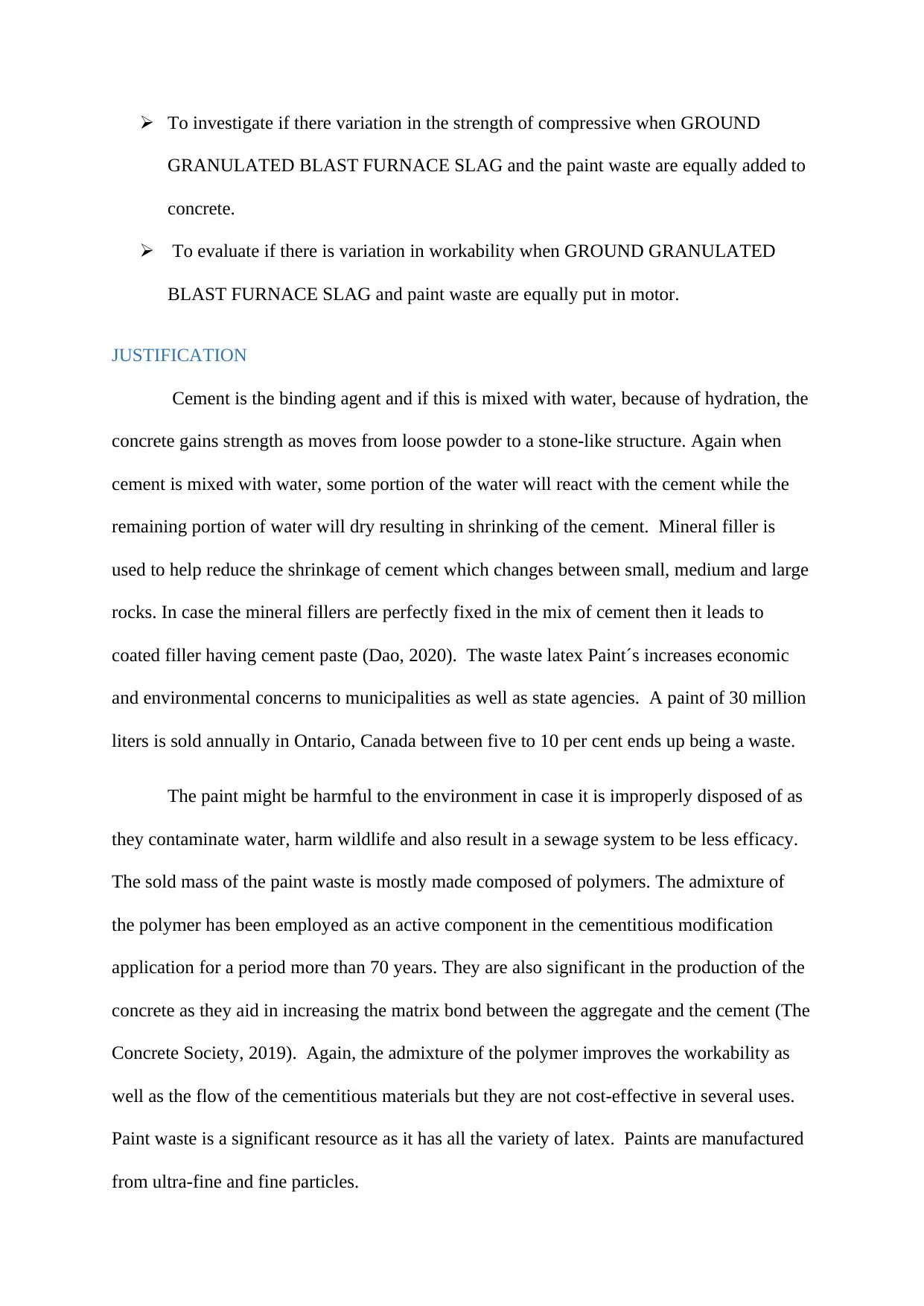
To investigate if there variation in the strength of compressive when GROUND
GRANULATED BLAST FURNACE SLAG and the paint waste are equally added to
concrete.
To evaluate if there is variation in workability when GROUND GRANULATED
BLAST FURNACE SLAG and paint waste are equally put in motor.
JUSTIFICATION
Cement is the binding agent and if this is mixed with water, because of hydration, the
concrete gains strength as moves from loose powder to a stone-like structure. Again when
cement is mixed with water, some portion of the water will react with the cement while the
remaining portion of water will dry resulting in shrinking of the cement. Mineral filler is
used to help reduce the shrinkage of cement which changes between small, medium and large
rocks. In case the mineral fillers are perfectly fixed in the mix of cement then it leads to
coated filler having cement paste (Dao, 2020). The waste latex Paint´s increases economic
and environmental concerns to municipalities as well as state agencies. A paint of 30 million
liters is sold annually in Ontario, Canada between five to 10 per cent ends up being a waste.
The paint might be harmful to the environment in case it is improperly disposed of as
they contaminate water, harm wildlife and also result in a sewage system to be less efficacy.
The sold mass of the paint waste is mostly made composed of polymers. The admixture of
the polymer has been employed as an active component in the cementitious modification
application for a period more than 70 years. They are also significant in the production of the
concrete as they aid in increasing the matrix bond between the aggregate and the cement (The
Concrete Society, 2019). Again, the admixture of the polymer improves the workability as
well as the flow of the cementitious materials but they are not cost-effective in several uses.
Paint waste is a significant resource as it has all the variety of latex. Paints are manufactured
from ultra-fine and fine particles.
GRANULATED BLAST FURNACE SLAG and the paint waste are equally added to
concrete.
To evaluate if there is variation in workability when GROUND GRANULATED
BLAST FURNACE SLAG and paint waste are equally put in motor.
JUSTIFICATION
Cement is the binding agent and if this is mixed with water, because of hydration, the
concrete gains strength as moves from loose powder to a stone-like structure. Again when
cement is mixed with water, some portion of the water will react with the cement while the
remaining portion of water will dry resulting in shrinking of the cement. Mineral filler is
used to help reduce the shrinkage of cement which changes between small, medium and large
rocks. In case the mineral fillers are perfectly fixed in the mix of cement then it leads to
coated filler having cement paste (Dao, 2020). The waste latex Paint´s increases economic
and environmental concerns to municipalities as well as state agencies. A paint of 30 million
liters is sold annually in Ontario, Canada between five to 10 per cent ends up being a waste.
The paint might be harmful to the environment in case it is improperly disposed of as
they contaminate water, harm wildlife and also result in a sewage system to be less efficacy.
The sold mass of the paint waste is mostly made composed of polymers. The admixture of
the polymer has been employed as an active component in the cementitious modification
application for a period more than 70 years. They are also significant in the production of the
concrete as they aid in increasing the matrix bond between the aggregate and the cement (The
Concrete Society, 2019). Again, the admixture of the polymer improves the workability as
well as the flow of the cementitious materials but they are not cost-effective in several uses.
Paint waste is a significant resource as it has all the variety of latex. Paints are manufactured
from ultra-fine and fine particles.
Paraphrase This Document
Need a fresh take? Get an instant paraphrase of this document with our AI Paraphraser
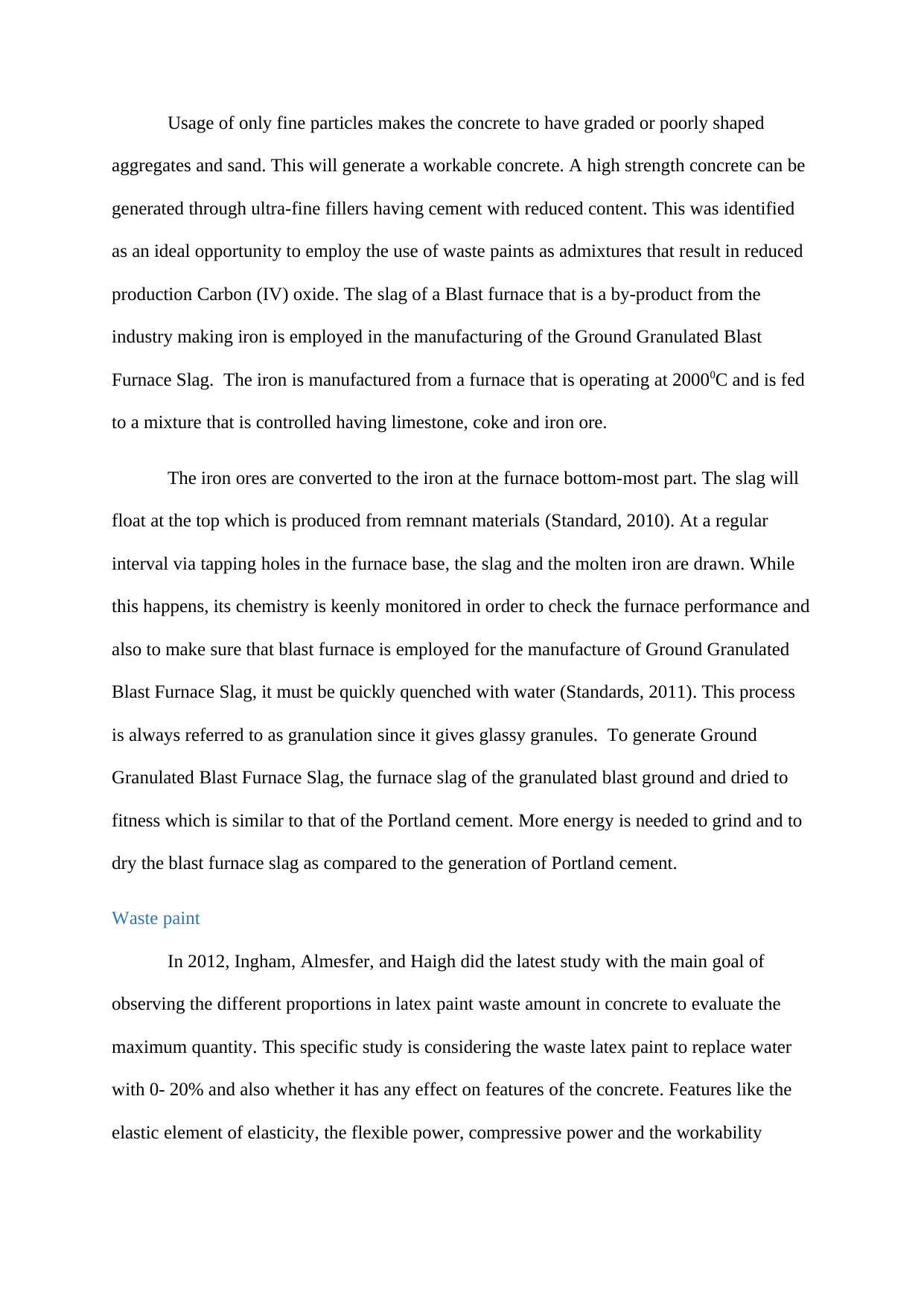
Usage of only fine particles makes the concrete to have graded or poorly shaped
aggregates and sand. This will generate a workable concrete. A high strength concrete can be
generated through ultra-fine fillers having cement with reduced content. This was identified
as an ideal opportunity to employ the use of waste paints as admixtures that result in reduced
production Carbon (IV) oxide. The slag of a Blast furnace that is a by-product from the
industry making iron is employed in the manufacturing of the Ground Granulated Blast
Furnace Slag. The iron is manufactured from a furnace that is operating at 20000C and is fed
to a mixture that is controlled having limestone, coke and iron ore.
The iron ores are converted to the iron at the furnace bottom-most part. The slag will
float at the top which is produced from remnant materials (Standard, 2010). At a regular
interval via tapping holes in the furnace base, the slag and the molten iron are drawn. While
this happens, its chemistry is keenly monitored in order to check the furnace performance and
also to make sure that blast furnace is employed for the manufacture of Ground Granulated
Blast Furnace Slag, it must be quickly quenched with water (Standards, 2011). This process
is always referred to as granulation since it gives glassy granules. To generate Ground
Granulated Blast Furnace Slag, the furnace slag of the granulated blast ground and dried to
fitness which is similar to that of the Portland cement. More energy is needed to grind and to
dry the blast furnace slag as compared to the generation of Portland cement.
Waste paint
In 2012, Ingham, Almesfer, and Haigh did the latest study with the main goal of
observing the different proportions in latex paint waste amount in concrete to evaluate the
maximum quantity. This specific study is considering the waste latex paint to replace water
with 0- 20% and also whether it has any effect on features of the concrete. Features like the
elastic element of elasticity, the flexible power, compressive power and the workability
aggregates and sand. This will generate a workable concrete. A high strength concrete can be
generated through ultra-fine fillers having cement with reduced content. This was identified
as an ideal opportunity to employ the use of waste paints as admixtures that result in reduced
production Carbon (IV) oxide. The slag of a Blast furnace that is a by-product from the
industry making iron is employed in the manufacturing of the Ground Granulated Blast
Furnace Slag. The iron is manufactured from a furnace that is operating at 20000C and is fed
to a mixture that is controlled having limestone, coke and iron ore.
The iron ores are converted to the iron at the furnace bottom-most part. The slag will
float at the top which is produced from remnant materials (Standard, 2010). At a regular
interval via tapping holes in the furnace base, the slag and the molten iron are drawn. While
this happens, its chemistry is keenly monitored in order to check the furnace performance and
also to make sure that blast furnace is employed for the manufacture of Ground Granulated
Blast Furnace Slag, it must be quickly quenched with water (Standards, 2011). This process
is always referred to as granulation since it gives glassy granules. To generate Ground
Granulated Blast Furnace Slag, the furnace slag of the granulated blast ground and dried to
fitness which is similar to that of the Portland cement. More energy is needed to grind and to
dry the blast furnace slag as compared to the generation of Portland cement.
Waste paint
In 2012, Ingham, Almesfer, and Haigh did the latest study with the main goal of
observing the different proportions in latex paint waste amount in concrete to evaluate the
maximum quantity. This specific study is considering the waste latex paint to replace water
with 0- 20% and also whether it has any effect on features of the concrete. Features like the
elastic element of elasticity, the flexible power, compressive power and the workability
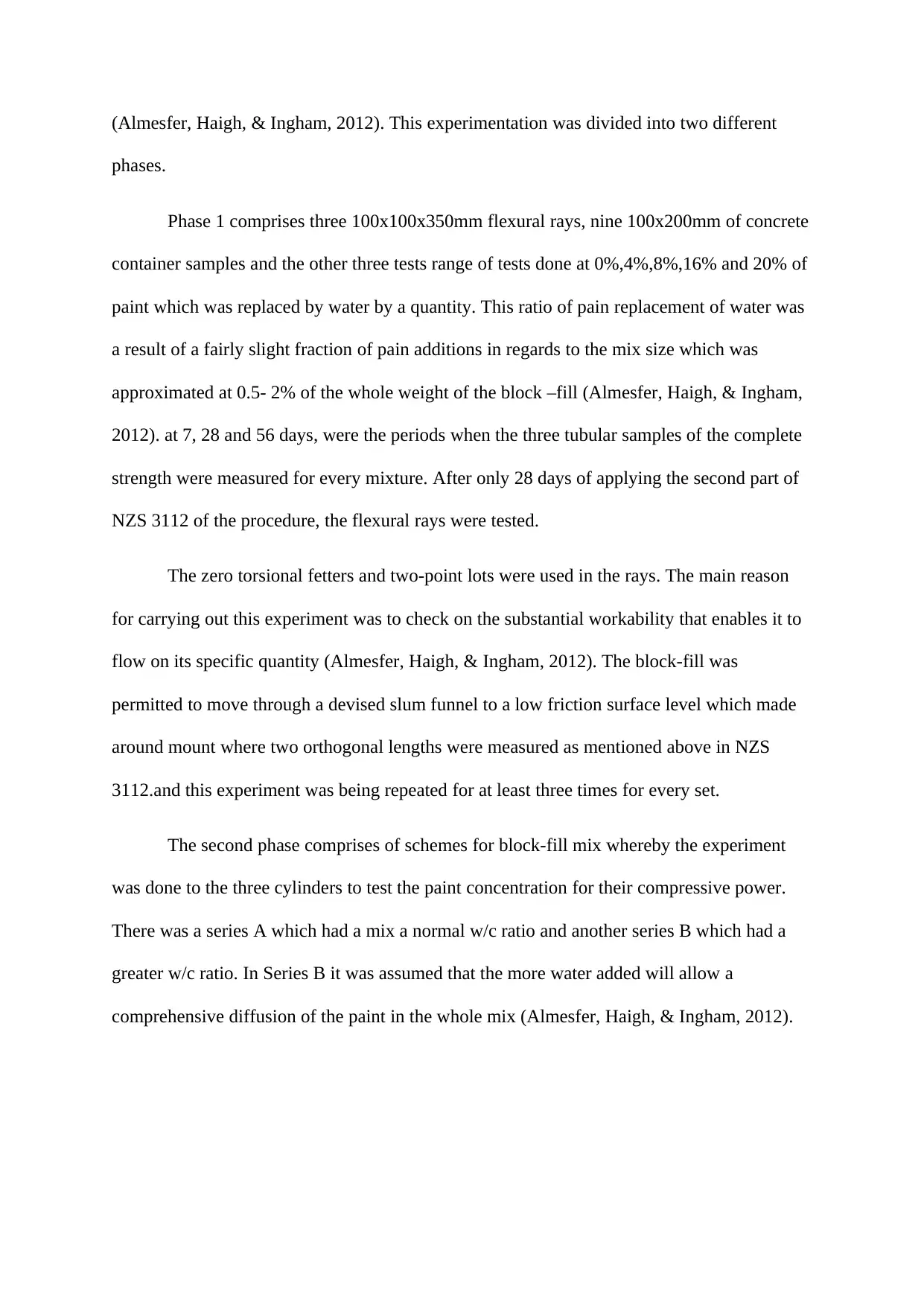
(Almesfer, Haigh, & Ingham, 2012). This experimentation was divided into two different
phases.
Phase 1 comprises three 100x100x350mm flexural rays, nine 100x200mm of concrete
container samples and the other three tests range of tests done at 0%,4%,8%,16% and 20% of
paint which was replaced by water by a quantity. This ratio of pain replacement of water was
a result of a fairly slight fraction of pain additions in regards to the mix size which was
approximated at 0.5- 2% of the whole weight of the block –fill (Almesfer, Haigh, & Ingham,
2012). at 7, 28 and 56 days, were the periods when the three tubular samples of the complete
strength were measured for every mixture. After only 28 days of applying the second part of
NZS 3112 of the procedure, the flexural rays were tested.
The zero torsional fetters and two-point lots were used in the rays. The main reason
for carrying out this experiment was to check on the substantial workability that enables it to
flow on its specific quantity (Almesfer, Haigh, & Ingham, 2012). The block-fill was
permitted to move through a devised slum funnel to a low friction surface level which made
around mount where two orthogonal lengths were measured as mentioned above in NZS
3112.and this experiment was being repeated for at least three times for every set.
The second phase comprises of schemes for block-fill mix whereby the experiment
was done to the three cylinders to test the paint concentration for their compressive power.
There was a series A which had a mix a normal w/c ratio and another series B which had a
greater w/c ratio. In Series B it was assumed that the more water added will allow a
comprehensive diffusion of the paint in the whole mix (Almesfer, Haigh, & Ingham, 2012).
phases.
Phase 1 comprises three 100x100x350mm flexural rays, nine 100x200mm of concrete
container samples and the other three tests range of tests done at 0%,4%,8%,16% and 20% of
paint which was replaced by water by a quantity. This ratio of pain replacement of water was
a result of a fairly slight fraction of pain additions in regards to the mix size which was
approximated at 0.5- 2% of the whole weight of the block –fill (Almesfer, Haigh, & Ingham,
2012). at 7, 28 and 56 days, were the periods when the three tubular samples of the complete
strength were measured for every mixture. After only 28 days of applying the second part of
NZS 3112 of the procedure, the flexural rays were tested.
The zero torsional fetters and two-point lots were used in the rays. The main reason
for carrying out this experiment was to check on the substantial workability that enables it to
flow on its specific quantity (Almesfer, Haigh, & Ingham, 2012). The block-fill was
permitted to move through a devised slum funnel to a low friction surface level which made
around mount where two orthogonal lengths were measured as mentioned above in NZS
3112.and this experiment was being repeated for at least three times for every set.
The second phase comprises of schemes for block-fill mix whereby the experiment
was done to the three cylinders to test the paint concentration for their compressive power.
There was a series A which had a mix a normal w/c ratio and another series B which had a
greater w/c ratio. In Series B it was assumed that the more water added will allow a
comprehensive diffusion of the paint in the whole mix (Almesfer, Haigh, & Ingham, 2012).
⊘ This is a preview!⊘
Do you want full access?
Subscribe today to unlock all pages.

Trusted by 1+ million students worldwide
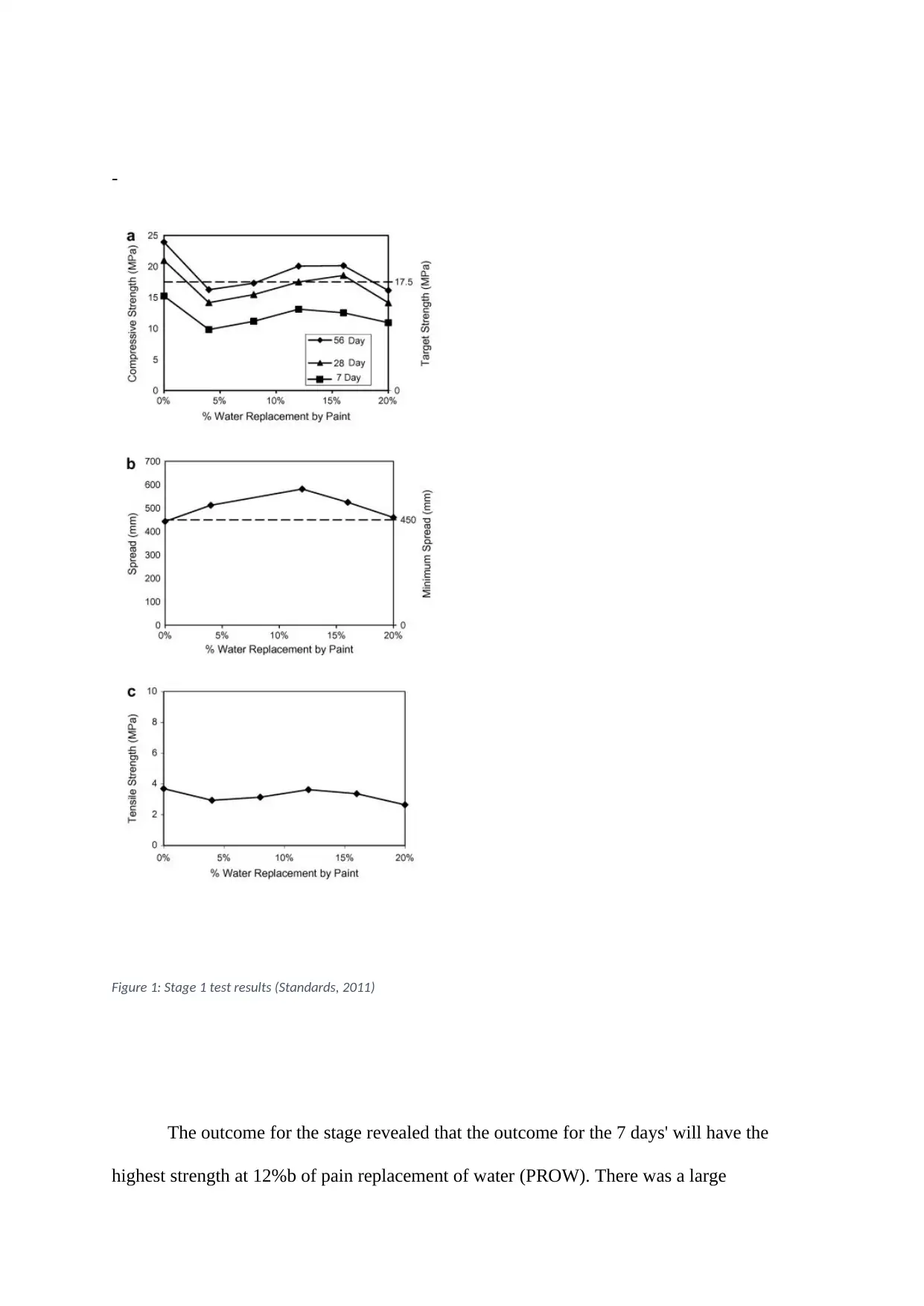
-
Figure 1: Stage 1 test results (Standards, 2011)
The outcome for the stage revealed that the outcome for the 7 days' will have the
highest strength at 12%b of pain replacement of water (PROW). There was a large
Figure 1: Stage 1 test results (Standards, 2011)
The outcome for the stage revealed that the outcome for the 7 days' will have the
highest strength at 12%b of pain replacement of water (PROW). There was a large
Paraphrase This Document
Need a fresh take? Get an instant paraphrase of this document with our AI Paraphraser
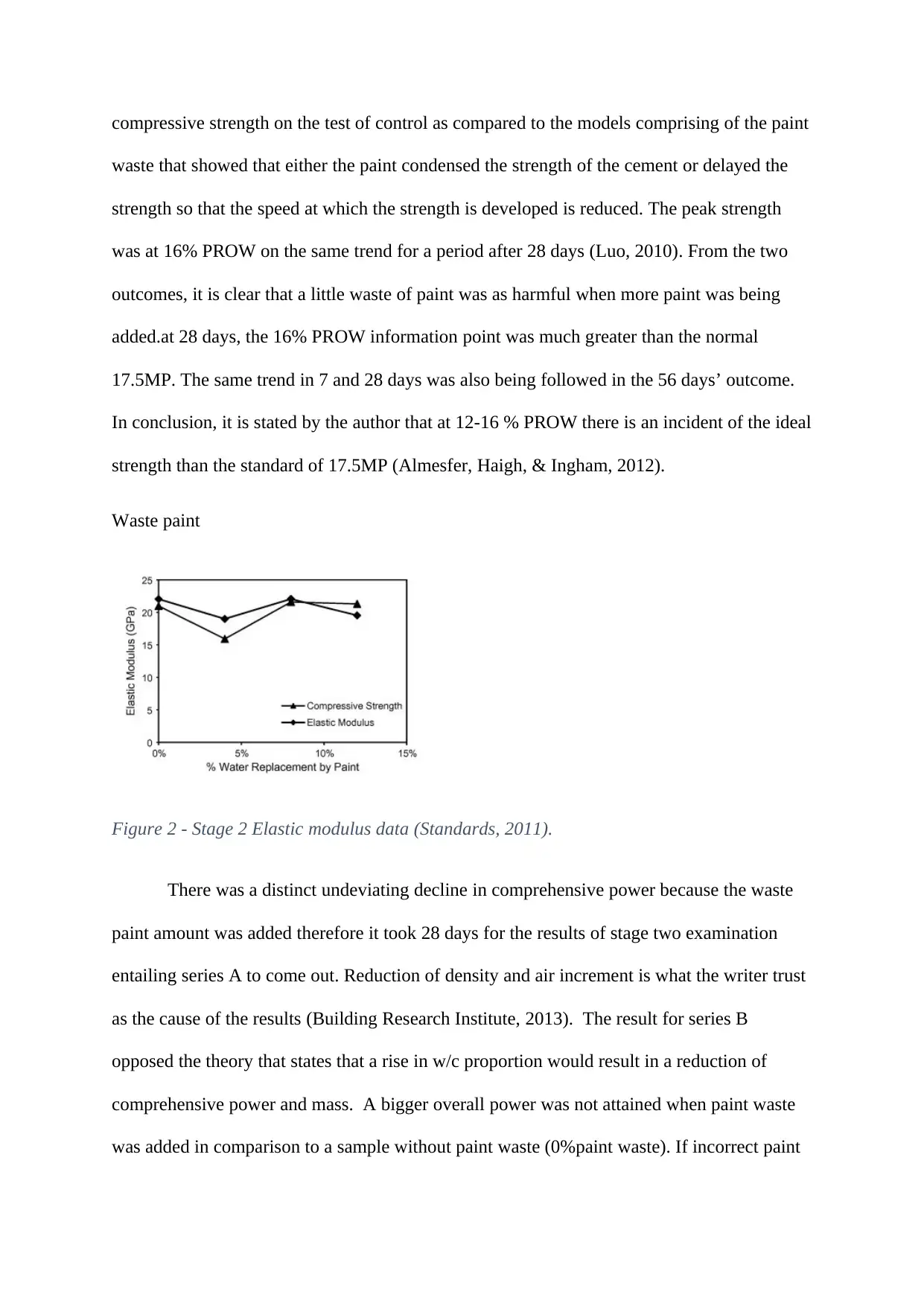
compressive strength on the test of control as compared to the models comprising of the paint
waste that showed that either the paint condensed the strength of the cement or delayed the
strength so that the speed at which the strength is developed is reduced. The peak strength
was at 16% PROW on the same trend for a period after 28 days (Luo, 2010). From the two
outcomes, it is clear that a little waste of paint was as harmful when more paint was being
added.at 28 days, the 16% PROW information point was much greater than the normal
17.5MP. The same trend in 7 and 28 days was also being followed in the 56 days’ outcome.
In conclusion, it is stated by the author that at 12-16 % PROW there is an incident of the ideal
strength than the standard of 17.5MP (Almesfer, Haigh, & Ingham, 2012).
Waste paint
Figure 2 - Stage 2 Elastic modulus data (Standards, 2011).
There was a distinct undeviating decline in comprehensive power because the waste
paint amount was added therefore it took 28 days for the results of stage two examination
entailing series A to come out. Reduction of density and air increment is what the writer trust
as the cause of the results (Building Research Institute, 2013). The result for series B
opposed the theory that states that a rise in w/c proportion would result in a reduction of
comprehensive power and mass. A bigger overall power was not attained when paint waste
was added in comparison to a sample without paint waste (0%paint waste). If incorrect paint
waste that showed that either the paint condensed the strength of the cement or delayed the
strength so that the speed at which the strength is developed is reduced. The peak strength
was at 16% PROW on the same trend for a period after 28 days (Luo, 2010). From the two
outcomes, it is clear that a little waste of paint was as harmful when more paint was being
added.at 28 days, the 16% PROW information point was much greater than the normal
17.5MP. The same trend in 7 and 28 days was also being followed in the 56 days’ outcome.
In conclusion, it is stated by the author that at 12-16 % PROW there is an incident of the ideal
strength than the standard of 17.5MP (Almesfer, Haigh, & Ingham, 2012).
Waste paint
Figure 2 - Stage 2 Elastic modulus data (Standards, 2011).
There was a distinct undeviating decline in comprehensive power because the waste
paint amount was added therefore it took 28 days for the results of stage two examination
entailing series A to come out. Reduction of density and air increment is what the writer trust
as the cause of the results (Building Research Institute, 2013). The result for series B
opposed the theory that states that a rise in w/c proportion would result in a reduction of
comprehensive power and mass. A bigger overall power was not attained when paint waste
was added in comparison to a sample without paint waste (0%paint waste). If incorrect paint
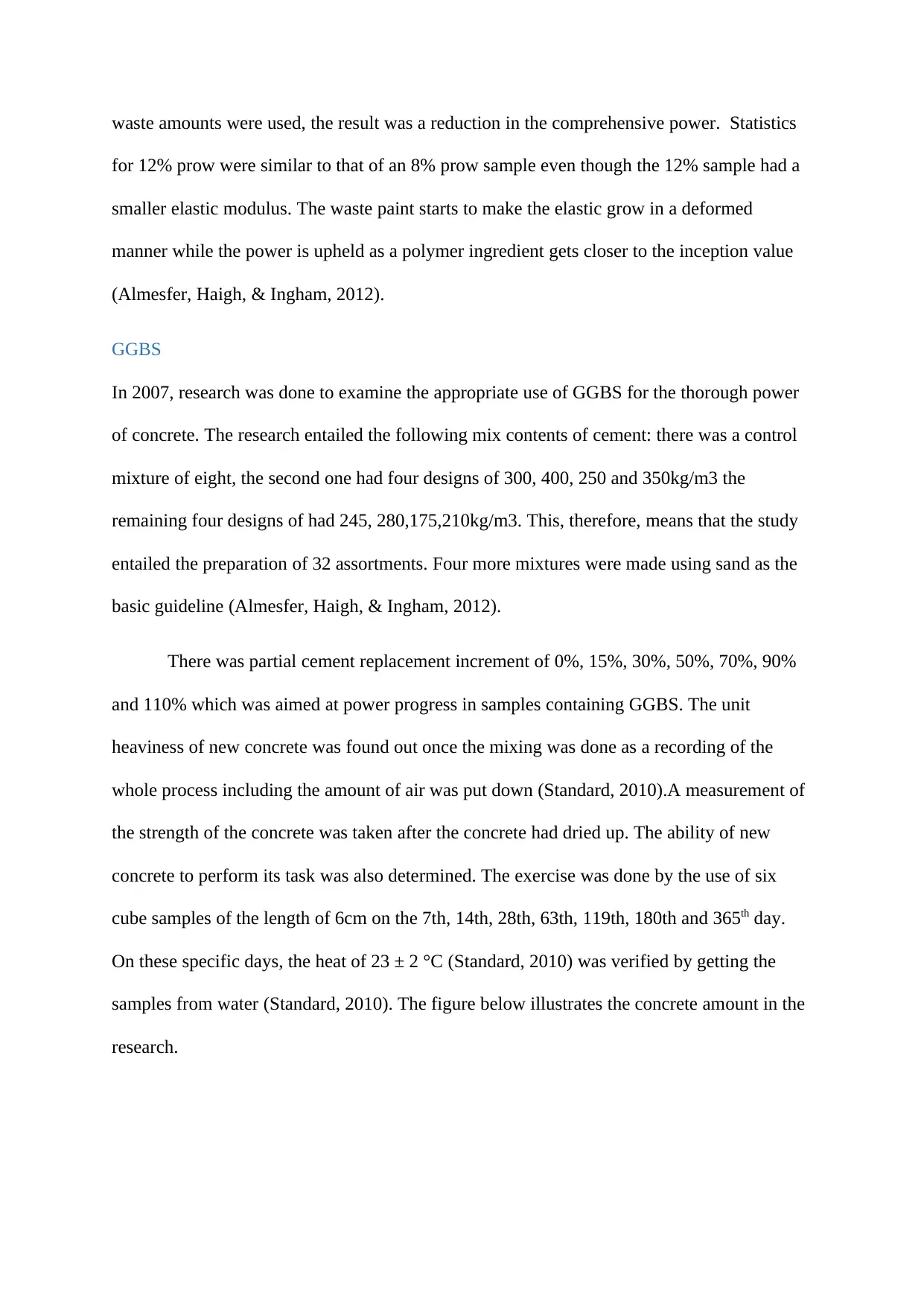
waste amounts were used, the result was a reduction in the comprehensive power. Statistics
for 12% prow were similar to that of an 8% prow sample even though the 12% sample had a
smaller elastic modulus. The waste paint starts to make the elastic grow in a deformed
manner while the power is upheld as a polymer ingredient gets closer to the inception value
(Almesfer, Haigh, & Ingham, 2012).
GGBS
In 2007, research was done to examine the appropriate use of GGBS for the thorough power
of concrete. The research entailed the following mix contents of cement: there was a control
mixture of eight, the second one had four designs of 300, 400, 250 and 350kg/m3 the
remaining four designs of had 245, 280,175,210kg/m3. This, therefore, means that the study
entailed the preparation of 32 assortments. Four more mixtures were made using sand as the
basic guideline (Almesfer, Haigh, & Ingham, 2012).
There was partial cement replacement increment of 0%, 15%, 30%, 50%, 70%, 90%
and 110% which was aimed at power progress in samples containing GGBS. The unit
heaviness of new concrete was found out once the mixing was done as a recording of the
whole process including the amount of air was put down (Standard, 2010).A measurement of
the strength of the concrete was taken after the concrete had dried up. The ability of new
concrete to perform its task was also determined. The exercise was done by the use of six
cube samples of the length of 6cm on the 7th, 14th, 28th, 63th, 119th, 180th and 365th day.
On these specific days, the heat of 23 ± 2 °C (Standard, 2010) was verified by getting the
samples from water (Standard, 2010). The figure below illustrates the concrete amount in the
research.
for 12% prow were similar to that of an 8% prow sample even though the 12% sample had a
smaller elastic modulus. The waste paint starts to make the elastic grow in a deformed
manner while the power is upheld as a polymer ingredient gets closer to the inception value
(Almesfer, Haigh, & Ingham, 2012).
GGBS
In 2007, research was done to examine the appropriate use of GGBS for the thorough power
of concrete. The research entailed the following mix contents of cement: there was a control
mixture of eight, the second one had four designs of 300, 400, 250 and 350kg/m3 the
remaining four designs of had 245, 280,175,210kg/m3. This, therefore, means that the study
entailed the preparation of 32 assortments. Four more mixtures were made using sand as the
basic guideline (Almesfer, Haigh, & Ingham, 2012).
There was partial cement replacement increment of 0%, 15%, 30%, 50%, 70%, 90%
and 110% which was aimed at power progress in samples containing GGBS. The unit
heaviness of new concrete was found out once the mixing was done as a recording of the
whole process including the amount of air was put down (Standard, 2010).A measurement of
the strength of the concrete was taken after the concrete had dried up. The ability of new
concrete to perform its task was also determined. The exercise was done by the use of six
cube samples of the length of 6cm on the 7th, 14th, 28th, 63th, 119th, 180th and 365th day.
On these specific days, the heat of 23 ± 2 °C (Standard, 2010) was verified by getting the
samples from water (Standard, 2010). The figure below illustrates the concrete amount in the
research.
⊘ This is a preview!⊘
Do you want full access?
Subscribe today to unlock all pages.

Trusted by 1+ million students worldwide
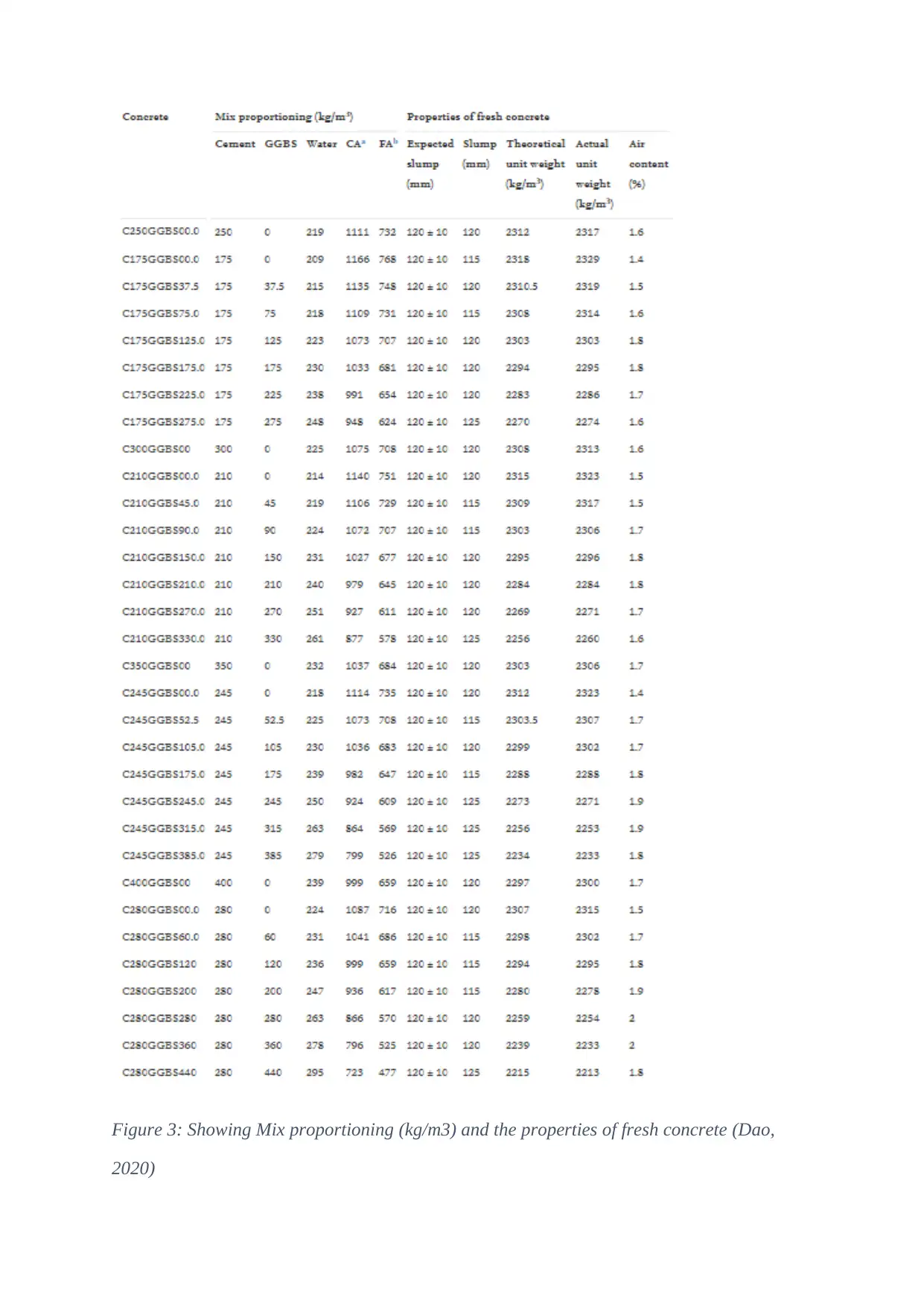
Figure 3: Showing Mix proportioning (kg/m3) and the properties of fresh concrete (Dao,
2020)
2020)
Paraphrase This Document
Need a fresh take? Get an instant paraphrase of this document with our AI Paraphraser
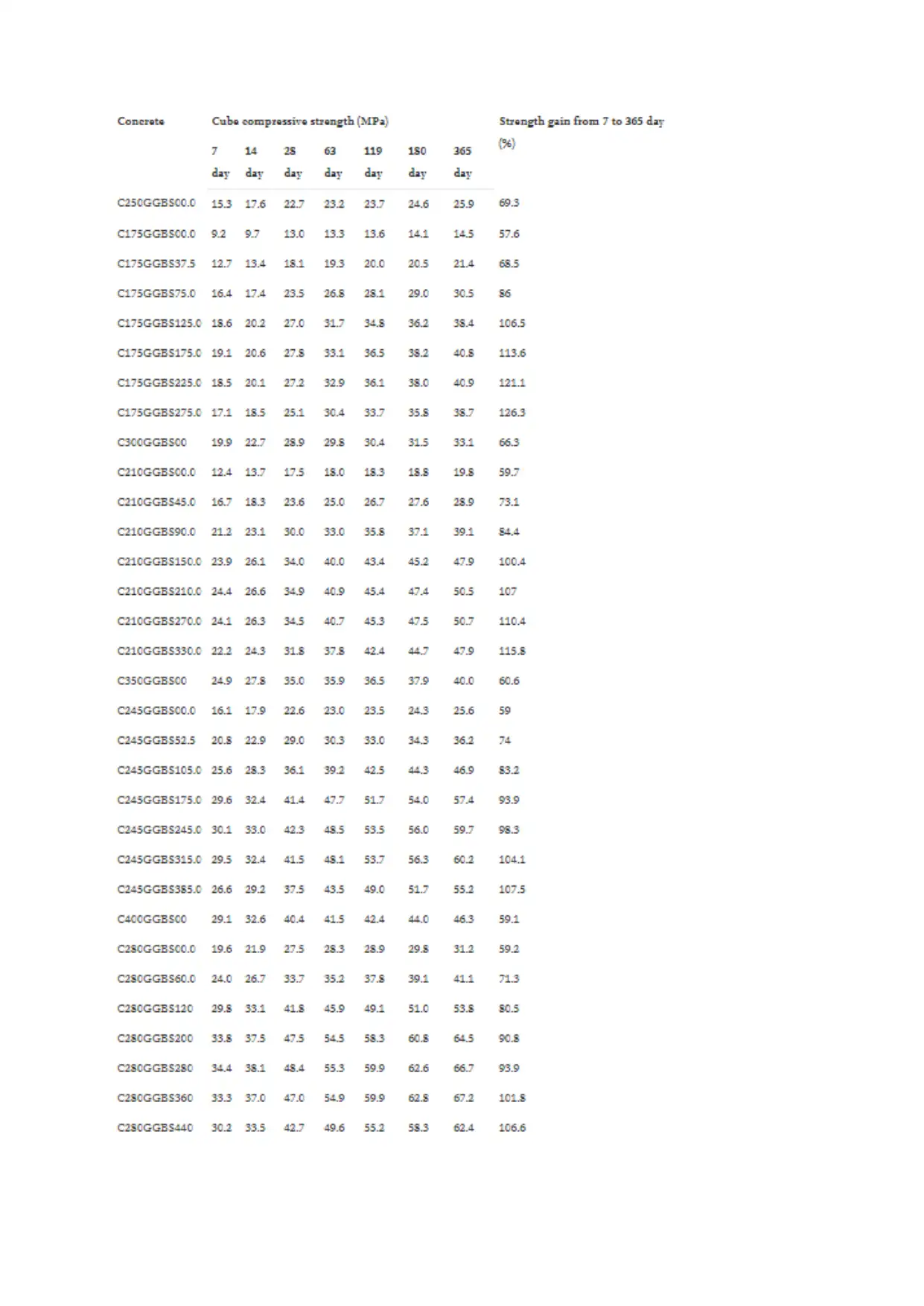
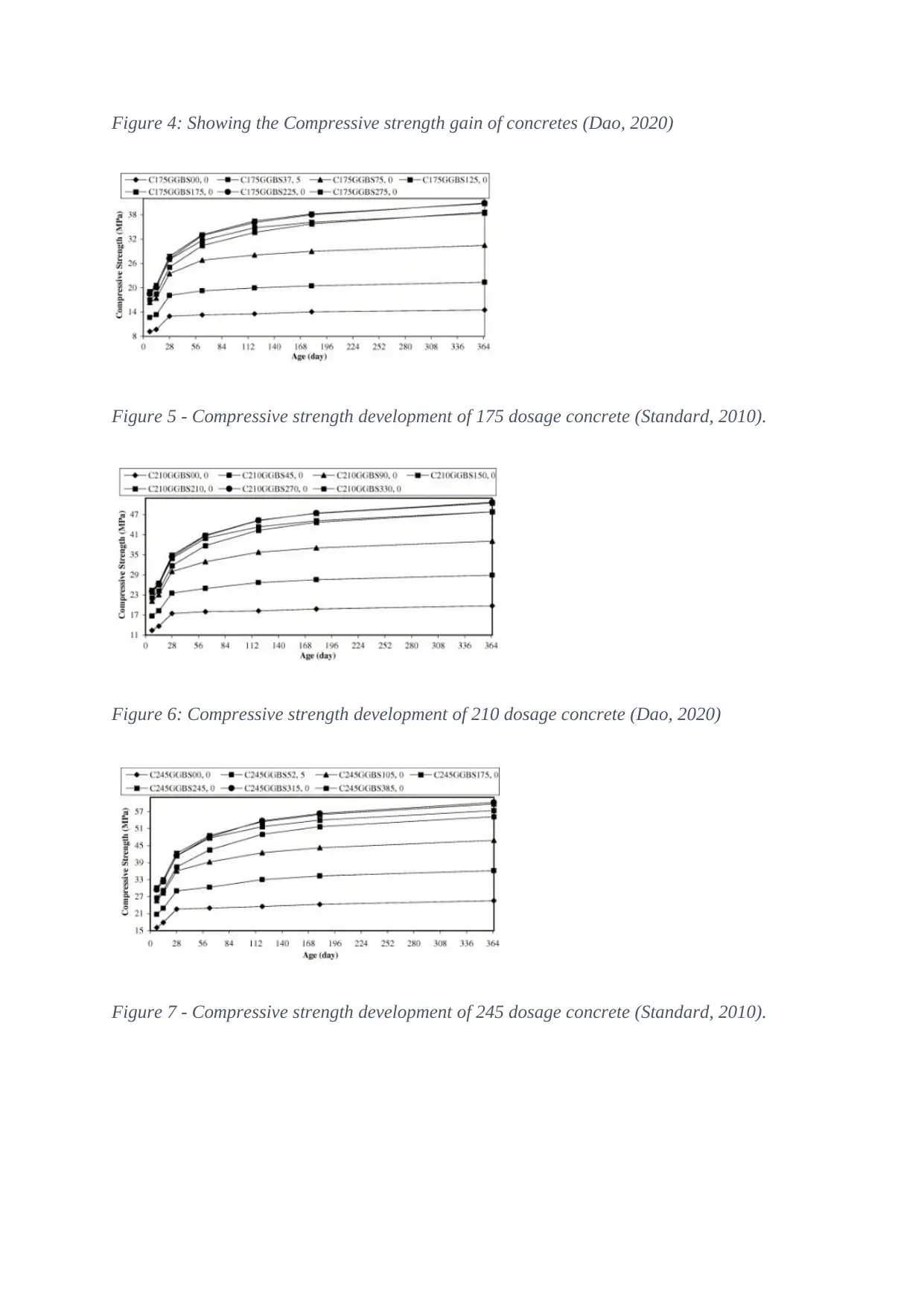
Figure 4: Showing the Compressive strength gain of concretes (Dao, 2020)
Figure 5 - Compressive strength development of 175 dosage concrete (Standard, 2010).
Figure 6: Compressive strength development of 210 dosage concrete (Dao, 2020)
Figure 7 - Compressive strength development of 245 dosage concrete (Standard, 2010).
Figure 5 - Compressive strength development of 175 dosage concrete (Standard, 2010).
Figure 6: Compressive strength development of 210 dosage concrete (Dao, 2020)
Figure 7 - Compressive strength development of 245 dosage concrete (Standard, 2010).
⊘ This is a preview!⊘
Do you want full access?
Subscribe today to unlock all pages.

Trusted by 1+ million students worldwide
1 out of 19
Related Documents
Your All-in-One AI-Powered Toolkit for Academic Success.
+13062052269
info@desklib.com
Available 24*7 on WhatsApp / Email
![[object Object]](/_next/static/media/star-bottom.7253800d.svg)
Unlock your academic potential
Copyright © 2020–2025 A2Z Services. All Rights Reserved. Developed and managed by ZUCOL.



